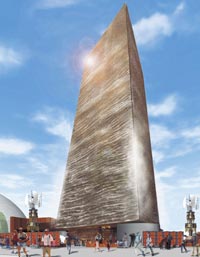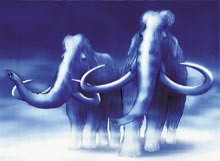|
Special Feature*
|
The world's largest kaleidoscope
The Earth Tower at the Nagoya City Pavilion
You have probably peered into a kaleidoscope and been amazed at the beautiful world of color inside. This experience will be magnified many times inside the world's largest kaleidoscope, Earth Tower, at the pavilion of Nagoya City. Nagoya is the capital of Aichi Prefecture, where Expo 2005 will be held.
The three-sided tower is about 47 meters high. Walk inside, look up, and a world of changing color unfolds. Acrylic discs installed on the ceiling let many-colored liquids swirl about. Rays of sunlight entering the tower pick up the colors and shine onto mirrors attached to the tower walls. What you see appears to be floating spherical bodies about 40 meters in diameter that keep changing their color.
Outside, water flows down the tower walls. The rough surfaces of these "Aqua Walls" make fascinating water patterns. Three nearby windmills turn in the breeze, emitting musical sounds.
The Earth Tower combines light, water and wind in a performance honoring nature and relaxing the minds of all who listen and watch.
|
 |

Lanterns around the tower will be decorated by paper cutout pictures donated by local residents, adding color to the plaza.
|
|

Why did mammoths become extinct? The project organized jointly by Japan and Russia shows how important it is to protect species from extinction.
|
Preserved in the Siberian permafrost
A Mammoth from Russia, at Global House
Mammoths became extinct about 10,000 years ago, but one excavated from the permafrost in Siberia will be exhibited in the Expo's Global House. This will be the first time in the world that a frozen mammoth is displayed for the general public.
The recently discovered adult mammoth is in a much better condition than others found previously. The head has two complete tusks, hair still covers the skin and flesh of the head, one of the ears is fully intact, and one eye socket still has an eyelid.
At the Expo, the most advanced techniques available in Japan will explore what life would have been like for mammoths. Computer images will show the inside of the body of the specimen on display, without damaging it in any way. You can see how it lived. Another exhibit will simulate its environment, including the vegetation.
Scientists are still not sure why mammoths became extinct. Some put it down to over-hunting by people, others to climate change. But we do know they once lived in the same area as people, and can ask ourselves what their message would be for us today. 
|

